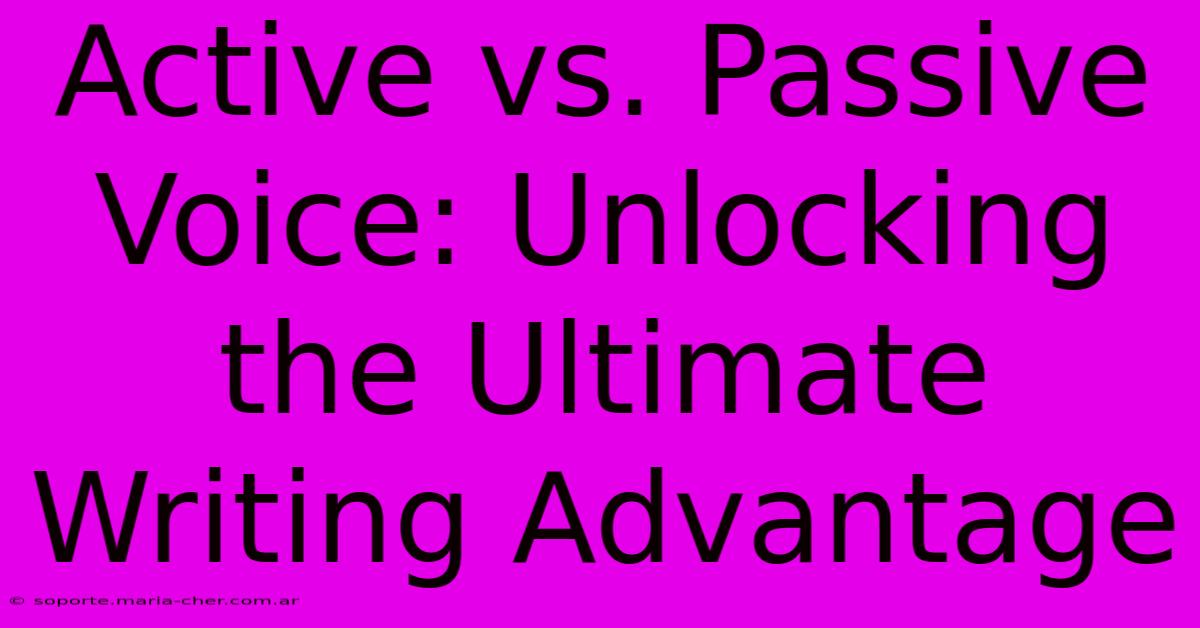Active Vs. Passive Voice: Unlocking The Ultimate Writing Advantage

Table of Contents
Active vs. Passive Voice: Unlocking the Ultimate Writing Advantage
Choosing between active and passive voice is a fundamental decision in writing that significantly impacts clarity, style, and impact. While both have their place, understanding their strengths and weaknesses is key to unlocking your writing's ultimate advantage. This article will delve into the nuances of active and passive voice, providing you with the tools to make informed choices that elevate your writing.
What is Active Voice?
Active voice is a sentence structure where the subject performs the action. The formula is simple: Subject + Verb + Object.
Example: The dog chased the ball.
Here, "dog" (subject) performs the action of "chasing" (verb) the "ball" (object). Active voice is generally preferred because it's:
- Clearer and more concise: The meaning is immediately apparent.
- More direct and engaging: It creates a stronger, more dynamic feel.
- More impactful: It emphasizes the subject's role and responsibility.
What is Passive Voice?
Passive voice reverses the subject-verb-object order. The action is done to the subject, rather than by the subject. The formula often includes a form of "to be" and a past participle:
Example: The ball was chased by the dog.
Here, the focus shifts from the dog to the ball. While seemingly minor, this change alters the emphasis and can lead to ambiguity. Passive voice is often used when:
- The actor is unknown or unimportant: The window was broken.
- The writer wants to avoid assigning blame: Mistakes were made.
- Emphasis is on the action, not the actor: The experiment was conducted carefully.
When to Use Active Voice
Active voice is your go-to choice in most situations. Its clarity and directness make it ideal for:
- News articles: Immediate and factual reporting demands active voice.
- Technical writing: Precision and clarity are paramount.
- Marketing materials: Engaging readers requires active, strong verbs.
- Creative writing: Active voice creates a more vivid and dynamic narrative.
- Business communications: Concise and direct communication is crucial.
Strengthening Your Writing with Active Voice
Let's examine how to convert passive sentences into active ones:
Passive: The report was written by John.
Active: John wrote the report.
Passive: The meeting was attended by many people.
Active: Many people attended the meeting.
When to Use Passive Voice
While generally less impactful, passive voice has its applications:
- To emphasize the action rather than the actor: The painting was meticulously crafted.
- To de-emphasize the actor: Mistakes were made in the planning stages. (Avoiding direct blame)
- When the actor is unknown: The car was stolen.
- To create a more formal or objective tone: Studies have shown...
Recognizing and Correcting Passive Voice
Look for forms of "to be" (is, am, are, was, were, been, being) combined with a past participle. If the subject receives the action rather than performing it, it's likely passive.
The Active vs. Passive Voice Debate: Finding the Balance
The key isn't to eliminate passive voice entirely, but to use it judiciously. Overusing passive voice can lead to weak, wordy sentences that obscure meaning. Strive for a balance: leverage the clarity and impact of active voice while employing passive voice strategically when its unique advantages serve your purpose. Consistent, thoughtful application of both will significantly enhance your writing.
Mastering Voice: A Continuous Journey
Understanding the differences between active and passive voice is a crucial step towards becoming a more effective writer. Regularly reviewing your work and consciously choosing the appropriate voice for each sentence will refine your style and elevate the impact of your writing. By mastering the nuances of active and passive voice, you'll unlock the ultimate writing advantage—clear, concise, and engaging communication.

Thank you for visiting our website wich cover about Active Vs. Passive Voice: Unlocking The Ultimate Writing Advantage. We hope the information provided has been useful to you. Feel free to contact us if you have any questions or need further assistance. See you next time and dont miss to bookmark.
Featured Posts
-
A Sincere Regret Our Heartfelt Apology For The Disruption You Ve Experienced
Feb 08, 2025
-
Unlock The Secrets Of New York Citys Iconic Address 276 Fifth Avenue
Feb 08, 2025
-
The Game Changer How Uhs Ii Micro Sd Cards Can Transform Your Gaming Experience
Feb 08, 2025
-
Unveiled The Secrets Of The Legendary 1115 Broadway Nyc
Feb 08, 2025
-
Mlgo Reverse Split The Key To Unlocking Hidden Value
Feb 08, 2025
